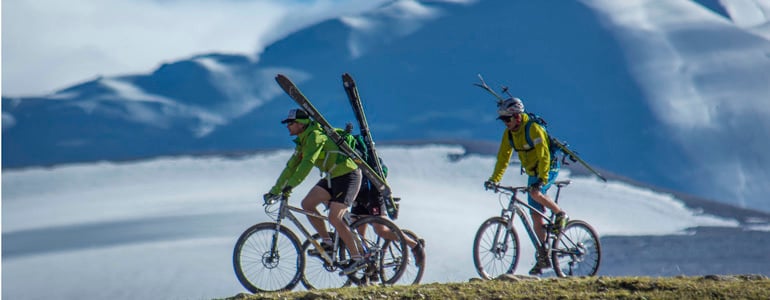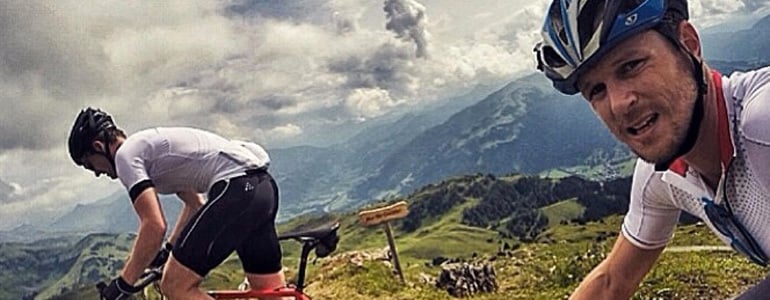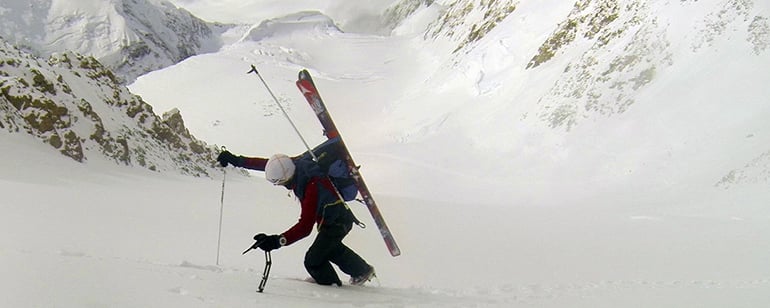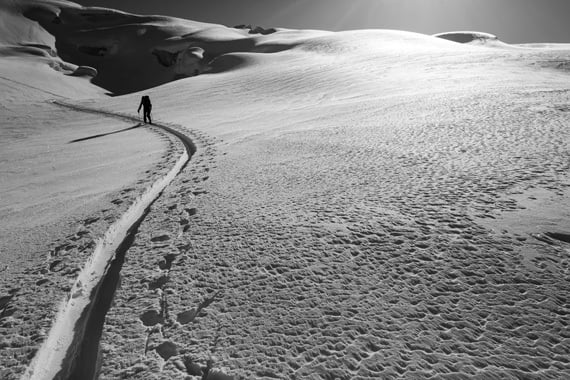

Suunto Blog

Mission to ski and ride the Himalayan greats
Three men, two 8,000ers, 7 days and 170km. Mode of transport? Bike and skis only. Welcome to the quest of ski mountaineers Benedikt Böhm, Sebastian Haag and Andrea Zambaldi. The German and Italian trio have just embarked on an epic mission to climb Shisha Pangma (8,013 m) then ride their bikes the 170 km to Cho Oyu (8,201 m) where they hope to make another speed ascent, all within a week.
They've spent the last week acclimatising up to 7,000 m and were all set to make their first summit attempt on Thursday September 18. However, bad weather and avalanche risk forced them to turn around. They're now back in base camp, preparing for a second summit bid.“Another attempt to climb Shisha Pangma is being planned and scheduled to happen within the next few days,” they blogged.
Big surprise of the trip so far? Bumping into Suunto ambassador Ueli Steck at base camp, no stranger to speed ascents himself.“Ueli gave many useful tips,” the guys said. Ueli climbed Shisha Pangma and Cho Oyu in 2011. The three ski mountaineers, who are supported by Suunto, can be followed online here.
All images © Elias Lefas

And the winners are...
Our #SuuntoAdventure selfie contest has now come to an end and we're pleased to reveal the four winners below. They will each receive the new Ambit3 Sport.
Selfies are everywhere. Whether it's on the top of a mountain or out on the trail, everyone loves to grab a selfie to share with friends. So at Suunto, we thought it would be a great idea to invite our fans and the wider community to send us their best shots.
We were overwhelmed by the response, receiving thousands of inspiring entries via Instagram. The four winning shots were each selected by one of our Suunto ambassadors – Kilian Jornet, Emelie Forsberg, Conrad Stoltz and Greg Hill.
Below, we present each ambassador's choice. Thanks to everyone who submitted images. It was a difficult choice.
In the coming weeks we'll have interviews with each of the winners to hear more about the story behind their shots.
Emelie Forsberg choice:
Winner: Patrick Müller Suarez, @patrickamsSays Emelie: “This picture captured my imagination right away with the light – is it morning or evening? – and made me think of a long day out exploring new mountains. The picture exudes exploration.”
Kilian Jornet choice:
Winner: Trent Busenbark, @trentbusenbarkSays Kilian: “The picture takes us right there and lets us feel what he feels. We can feel the cold, the storm, the tiredness. Adventure is also about bad conditions and hard times that make us happy when we come home.”
Conrad Stoltz choice:
Winner: Ross Lovell, @rosslovellSays Conrad: “I can see how crazy steep the hill is by the gear your friend is standing on! You deserve to win for riding one handed and snapping a great photo after such a massive climb!”
Greg Hill choice:
Winner: Corky Still, @akskicaSays Greg: “The vast background, untouched and waiting feels like unconquered territory. And there is excitement and unlimited potential to this skier. So many ski lines waiting for them...”

Tutorial Tuesday: Find a GPS signal more quickly
To receive a GPS signal your Suunto watch needs to locate satellites that are orbiting the Earth. The better the watch knows where the satellites are located, the quicker it will receive the signal.
Since the satellites are moving constantly, the new locations of the satellites need to be synced to your watch. Simply put, to find the satellites quicker, sync your watch regularly with Suunto app.
Suunto app sync the latest, seven-day satellite orbit forecast to your watch so it knows where to look. If you want to optimize and find the signal quickly, sync the watch as close to your activity as possible.
The data that is synced to your watch is global. So even if you sync your watch in New York and start your run 12 hours later in Chamonix, there is no need to re-sync.
Image: © Bruno LongGet support for your Suunto product at support

Pedaling to volcanic peaks
Brody Leven recently cycled from Portland, Oregon to Seattle, Washington, with the goal of climbing and skiing huge volcanoes that were 'on the way'. Surprisingly, he tells us the downhills were harder than the ascents...
What the idea behind this trip? The goal was for two college friends, who hadn't had an adventure together in years, to ride bikes from Portland to Seattle...the long, hard, and painful way – effectively tripling the typical route's distance – in order to climb and ski Mt. Adams, Mt. St. Helens, and Mt. Rainier, three huge Washington volcanoes. Personally, I wanted to combine two activities that I love, ski mountaineering and bike touring. We also wanted to remind ourselves that we don't need big budgets, helicopters, worldly knowledge, or even a passport to have a good, old-fashioned adventure. What bike were you riding? It's a hybrid cyclocross/touring bike – a triple-ring, aluminum frame, with a carbon fork, fenders, comfortable touring seat, racks, five panniers, and customized single-axle trailer. I've only ridden the bike three times in four years: solo across the United States in six weeks, around the coastline of Hawaii in two weeks, and now the hard way from Portland to Seattle in two weeks. I'd never put a trailer on it before this trip.How hard is it to cycle with all that gear? It isn't even like riding a bicycle. It feels as though you're riding something different, something other than a bike, some sort of vehicle. If you look over your shoulder and swerve, you're going in the ditch (which I learnt the hard way). You can't just throw your leg over the top and start peddling – instead, you need to do this weird running push-start. The weight made it incredibly difficult to ever get out of the granny gear.How much did it all weigh? 150-200 pounds (68 kg - 90 kg) without me. Weight fluctuated with water and food supplies.
How were the downhills?I wasn't comfortable enough to really get moving fast down hills until ten days into the trip, when I started to use my body as a sail to slow down. This is noteworthy because going downhill was often much more difficult than going uphill, since my brakes were almost worthless with that much weight moving the bike. You had to keep it perfectly upright in order for it not to fall over, and the trailer was constantly in danger of jack-knifing. Road or off-road? Maybe 75 miles (120 km) we biked were on loose dirt, gravel, or sandy roads. But they accounted for about 90% of the trip's overall effort, as they were often on the biggest hills.Did you have to push? Not uphill! But descending hills was so hard that I occasionally had to step off and walk my bike for a while, allowing my brakepads and rims to cool off (they were very hot to the touch, noisy, and ineffective). Even walking it down hills was difficult, because balancing it perfectly upright was essential or all of the weight would topple it over.
Click here to see Brody's 120km ride from Portland to Hood River – and here to see his ski tour on Mt Adams. Biggest challenge of the trip? Riding the 15-mile, 3,500-foot, dirt, gravel, and sand Mt. Adams approach road after biking 40 miles that morning was so hard. Also, not eating every cinnamon roll and huckleberry shake in a 400-mile radius tested my self-control! All images ©Brody Leven. Check out more of his adventures on Brodyleven.com

Kilian's record ascent of Denali
When Kilian Jornet goes to the mountains on a personal project you can be sure the results will be interesting.
The mountain athlete does not disappoint. He's just returned from Denali, 6,194 m, the highest mountain in North America and sure enough, he's come back with a record – and an epic story to tell.
Avoiding the more popular West Rib route, Jornet headed up Rescue Gully on skis in his usual super fast style. By the time he returned exactly 11h and 48m later he'd smashed the record for the mountain's fastest ascent – by over five hours. The round trip involves an elevation gain of over 4,700 m and a distance of over 53 km.
What makes the ascent even more noteworthy is that conditions were bad for much of the ascent. Out of 16 days on the mountain, only three were good while blizzards, fog and low temperatures were the norm.
When Kilian set off on the summit bid, the thermometer was at -20ºC and the wind was gusting 40km/h.
“It has been a great adventure,” Kilian says. “Weather conditions were bad during much of the route. Yet, I managed to break the record, so I'm very satisfied. I took a different route rather than the usual one to avoid a stretch with fixed ropes because I wanted to stick to the values underlying the project – that is, attempting the record using as little equipment as possible, and without help.”
“I had to face two tough factors,” he adds. “On the one hand, the cold and the wind, which slowed me down throughout the route. On the other hand, the altitude, which affected me substantially from 5,000m.”
The summit was a special moment, he says, but not because of the view. “There was fog and I couldn't see a thing! But I thought ‘now my legs will finally stop hurting’!”
Denali, which is also known as McKinley, is one of the most forbidding peaks in the world. Although not as high as the Himalayan mountains, the Alaskan peak is notorious for its cold and brutal weather thanks to its proximity to the Arctic Circle. And with 4,000m of difference from base to summit, it features more vertical ascent than most mountains. Measured by topographic prominence it's the world's third most prominent peak after Everest and Aconcagua.
Image © Summits of My Life

Greg Hill's mountain moves
In the space of 31 days he skied to the equivalent of space and back. Last month Greg Hill clocked an incredible 100,628m – more than 10 times the height of Mt Everest. For anyone curious to see how Canadian ski mountaineer achieved the feat, below we show his daily gain, which reveal his super-human performance. Day after day, Greg skied for up to 10 hours to cover between 3,000m and 4,000m of vertical. Of course this doesn't answer the bigger question of how he was physically able to do it and for that only Greg can provide the answer. “It was a big mission,” says the 38-year-old Suunto ambassador, recovering at his home in Revelstoke, British Columbia. “It was as hard as anything I've done, waking up every morning and getting out there.” But he says the knowledge that at the top of every climb lay an awesome descent kept him going. “It was the best human powered powder month ever! It was ridiculous. This was 97% great skiing!”Check out where he went, his daily climbs the full stats of Greg's March Madness project on the links below. Looking for a highlight? Greg says his best day was March 11th. “I climbed three different summits and five different great lines,” he says.
And the worst? March 6th when warm weather conspired to create nightmare ski-touring conditions. “My skis were weighing probably 20kg there was so much snow stuck to them,” says Greg. “That was as bad as it was.”
March 1st: 4,255m
March 2nd: 4,648m
March 3rd: 4,087m
March 4th: 4,125m
March 5th: rest day
March 6th: 3,950m
March 7th: 4,141m
March 8th: 2,943m
March 9th: rest day
March 10th: 4,264m
March 11th: 4,340m
March 12th: 3,957m
March 13th: 4,518m
March 14th: rest day
March 15th: 4,186m
March 16th: 3,970m
March 17th: 4,127m
March 18th: 2,287m
March 19th: rest day
March 20th: 4,398m
March 21st: 3,793m
March 22nd: 3,812m
March 24th: 3,843m
March 25th: 3,050m
March 26th: 3,048m
March 27th: 4,290m
March 28th: 3,869m
March 29th: 3,973m
March 30th: 3,421m
March 31st: 3,167m
Image: ©Bruno Long














































































